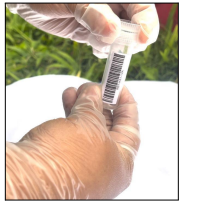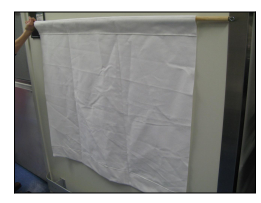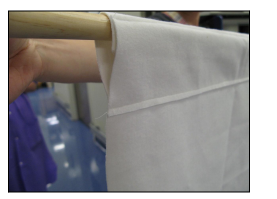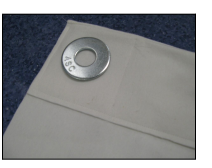T-1 TICK FIELD SAMPLING
REDI-NET Consortium
Disclaimer
This work is supported by the US Army Medical Research and Development Command under Contract No.W81XWH-21-C-0001, W81XWH-22-C-0093 and HT9425-23-C-0059. The views, opinions and/or findings contained in this report are those of the author(s) and should not be construed as an official Department of the Army or Navy position, policy or decision unless so designated by other documentation.
Abstract
This protocol describes tick field sampling.
Steps
TICK TRANSECT SELECTION
Find two suitable sampling locations at least 10-20 m away from the water body representing different ecological systems, if possible.
SAMPLING TEAMS
Field sampling of iDNA (tick) samples involves two people. One person serves as the ‘sampler’ and the other person serves as a ‘helper’. The helper can look up details in these instructions when needed, keep track of samples, handle objects that are contamination risks, serve as a second set of eyes for potential contamination, and ensure safety of the sampler in potentially hazardous field conditions.
Determine two 20m x 20m grid blocks for tick collections. Grid blocks should not be overlapping a location sampled the previous month’s collection trip. Each block-transect is composed of 5 ticks drags/passes.
The two grid-transects should be separated at least by 30 meters at the nearest points, when possible. Both transects should be in areas animals pass through to get to the watering hole.
TICK DRAGGING
Tick drags should not get very wet when sampling. Wait until the dew has burned off in the morning, and do not sample if it is raining.
For each transect, 5 tick-drags/passes should be performed; each tick-dragging being done in opposite directions (e.g., if the first drag of the first transect is oriented from North to South, the second drag should be performed from South to North, and so on).
Drag sampling should be performed by one person.
After each pass within the transect, turn the drag over and remove any ticks on the drag using tweezers to remove all ticks and place them in the appropriately labeled collection vial. No more than 10 live ticks should be placed in vial. All stages should be collected. Teams of two people can remove ticks from the drags (Figure 2).
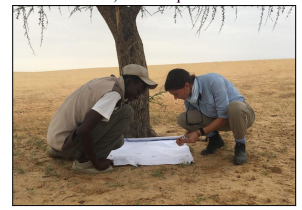
After collecting ticks from the drag from each pass, attention should be taken to remove any foreign object on the drags.
Place all labeled snap-cap vials from a completed transect into a Ziploc bag and into a cooler with wet towels in bottom with frozen water bottles, in order to slow them down.
Continue to the next transect and continue sampling ticks as in steps 1-10.
DO NOT mix ticks from different transects.
If needed, use a lint roller to remove debris, burrs or the remaining ticks prior to leaving the site.
The lint roller paper should be placed in a ziplock bag (labeled with a barcode) for transport back to the laboratory.
TICK STORAGE
Keep freshly collected ticks alive, keeping on a 4°C cold chain (cooler) until return to the laboratory. Ticks are not recommended to be stored at 4°C for long periods of time.
Once at the laboratory, if samples can not be processed on the same day of collection, all adult ticks (within field vials or on lint roller papers) must be individually sorted into appropriately labeled 1.5mL centrifuge tubes and should be stored at -80°C. Immature ticks remaining on lint roller papers should also be stored at -80°C until ready for testing. At -80°C, ticks can be stored for 2 months or longer.
If -80°C storage is unavailable, ticks should be stored at -20°C until processing. Ticks can be stored at -20°C for up to 2 months.
APPENDIX 1. TICK DRAG CONSTRUCTION -- TICK DRAG SUPPLIES FOR ONE TICK DRAG
One piece of white heavy-duty fabric with a soft nap, cut to approximately 1 square meter (39.5” x 39.5”). We used a waterproof white rubber sheeting (utility cloth) from JoAnn fabric and craft store (item #1491315), which is normally used to sew crib liners. White brushed bull denim could also be used (this should have a softer nap than regular bull denim).
Two smaller pieces of the same fabric cut to 39.5” x 4” and 39.5” x 3”. These will be sewn to the top and bottom of the flag to hold the dowel and the washers.
2 eye hook screws for each end of the dowel, ours are size #12.
3 large flat washers to weight the back of the flag, 1-3/4” diameter, 1/8” thick.
1 length of rope, 9 ft long.
1 48” dowel, ¾” in diameter.
APPENDIX 2. HOW TO REMOVE A TICK ATTACHED TO SKIN
Use fine-tipped forceps to grasp the tick as close to the skin's surface as possible.
Pull upward with steady, even pressure. Don't twist or jerk the tick; this can cause the mouth-parts to break off and remain in the skin. If this happens, remove the mouth-parts with forceps. If you are unable to remove the mouth easily with clean forceps, leave it alone and let the skin heal.
After removing the tick, thoroughly clean the bite area and your hands with rubbing alcohol, an iodine scrub, or soap and water.
Store the tick individually in ethanol and note the estimated duration of time the tick was attached. If desired, these ticks can be sent with those collected from the sampling areas for pathogen testing.
Seek medical attention if a rash or eschar appears around the site of attachment, and monitor for other symptoms including fever, fatigue, malaise, and any other abnormal symptoms. Be sure to inform the physician that you have been conducting tick research, and that a tick-borne disease is possibly responsible for symptoms.
